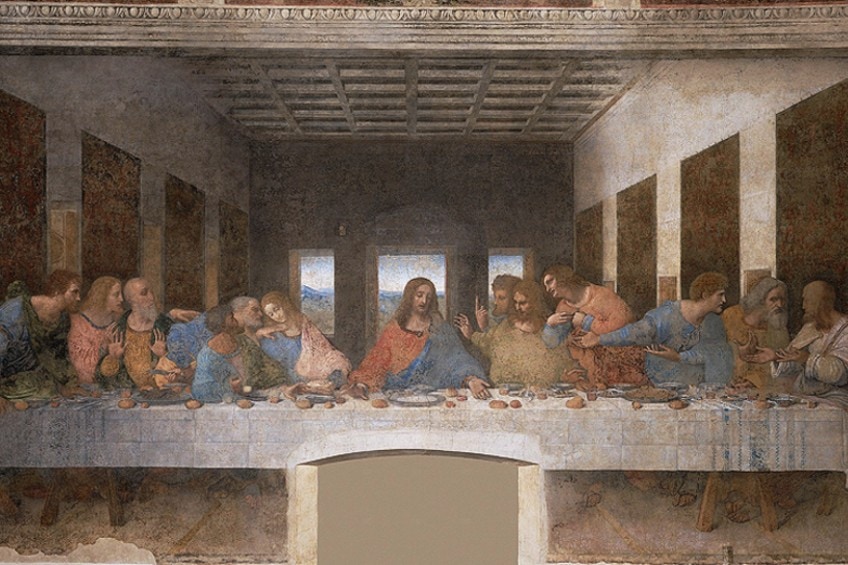“The Last Supper” by Da Vinci – “The Last Supper” Painting Study
The Last Supper (c. 1495 – 1498) by Leonardo da Vinci is a painting almost everyone has heard of. Famous for the Mona Lisa (1503) at the Louvre in Paris, Da Vinci’s earlier work, The Last Supper has been praised for many fine features and today we will be diving into the painting, its maker, and its history. Keep reading for a refreshing introduction to The Last Supper by Da Vinci.
Leonardo da Vinci: Artist and Polymath
| Artist Name | Leonardo di ser Piero da Vinci |
| Date of Birth | 15 April 1482 |
| Date of Death | 2 May 1519 |
| Place of Birth | Vinci, Republic of Florence |
| Movements, style, themes | High Renaissance, Italian Renaissance |
| Mediums | Painting, drawing, architecture, sculpture, science, engineering |
Speculated to have been painted between 1495 and 1498, The Last Supper is an iconic religious mural painting that depicts one of the most significant biblical scenes of Jesus Christ. Who painted The Last Supper you may ask? It is none other than Leonardo da Vinci, born in 1482, and is now known to be the primary founding figure of the High Renaissance.
Leonardo da Vinci was a man of many talents who specialized in many disciplines, including engineering, draftsmanship, science, and architecture.
You have likely come across his name echoed after his most famous masterpiece, the Mona Lisa. Before the Mona Lisa, Da Vinci had been working on a long-term project, The Last Supper, since 1495. The artist received his artistic training from a notable Italian sculptor and painter, Andrea del Verrocchio of Florence. Da Vinci worked across Rome, Milan, and Florence, gaining a significant following during his creative practice.
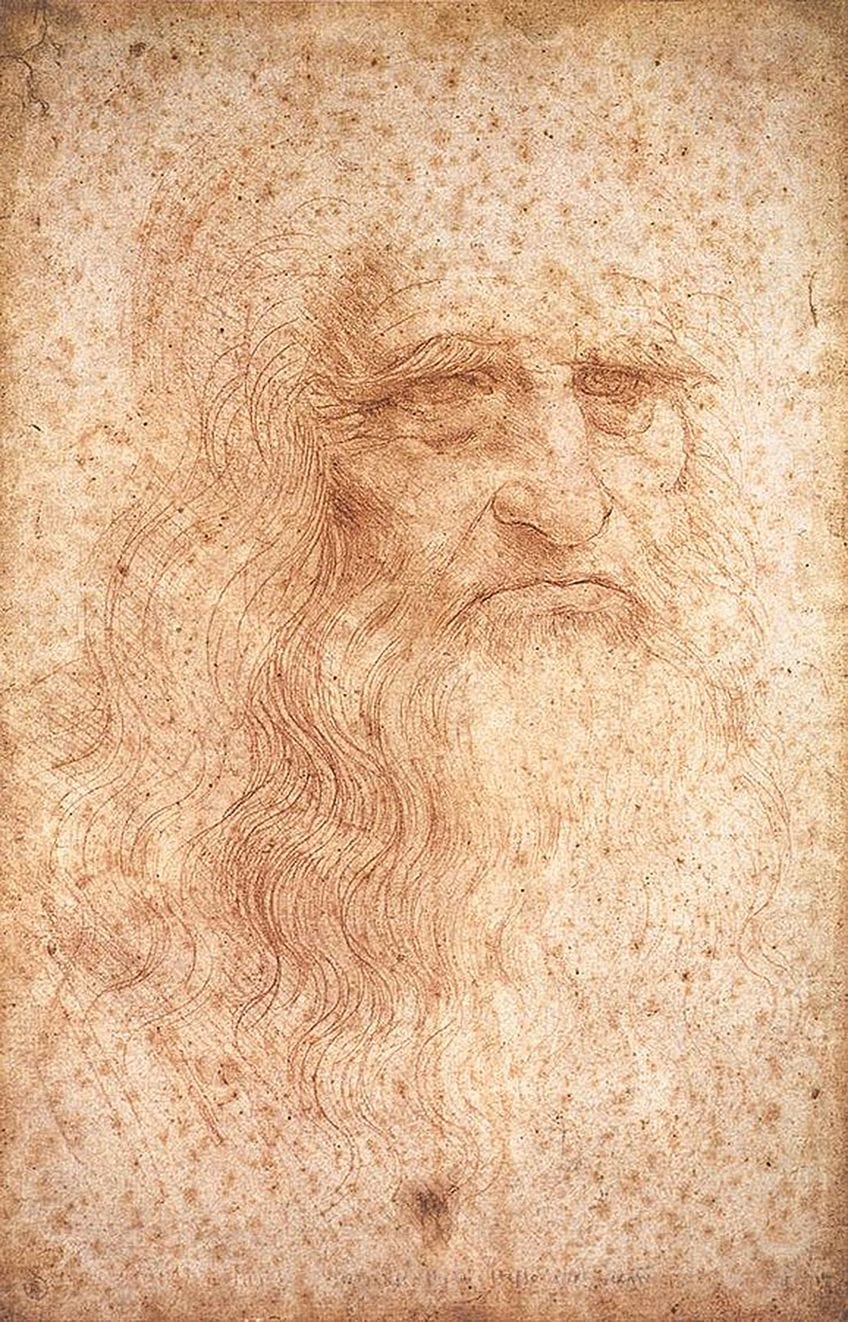
Da Vinci’s work traversed many themes, including anatomy, astronomy, cartography, paleontology, and even botany. In other words, considering the time, we can say that Da Vinci was the culmination of the ideals of the Humanist movement of the Renaissance. The creative genius’ contribution to art history was so profound that many of his works became the influential driving force behind other younger masters such as Michelangelo.
Aside from his creative practice, Da Vinci was also a technical genius. Having conceptualized armored battle vehicles, flying machines, the ratio machine, and the double hull, Da Vinci left no room for his curiosity to wonder.
The Last Supper by Da Vinci
| Date | c. 1495 – 1498 |
| Medium | Tempera on gesso, pitch, mastic |
| Dimensions (cm) | 460 x 880 |
| Where It Is Housed | Santa Maria delle Grazie, Milan |
If there is one thing Da Vinci was famous for, aside from being one of the greatest painters of the High Renaissance, it was his record for leaving artworks unfinished. The Last Supper is considered the most reproduced religious artwork to exist for its depiction of the biblical scene showcasing the 12 apostles of Jesus Christ seated at a large table with Christ in the center. The next section will take you through an analysis of The Last Supper original.
The Last Supper was commissioned by the artist’s patron and Duke of Milan, Ludovico Sforza, who requested Da Vinci to work on a renovation project.
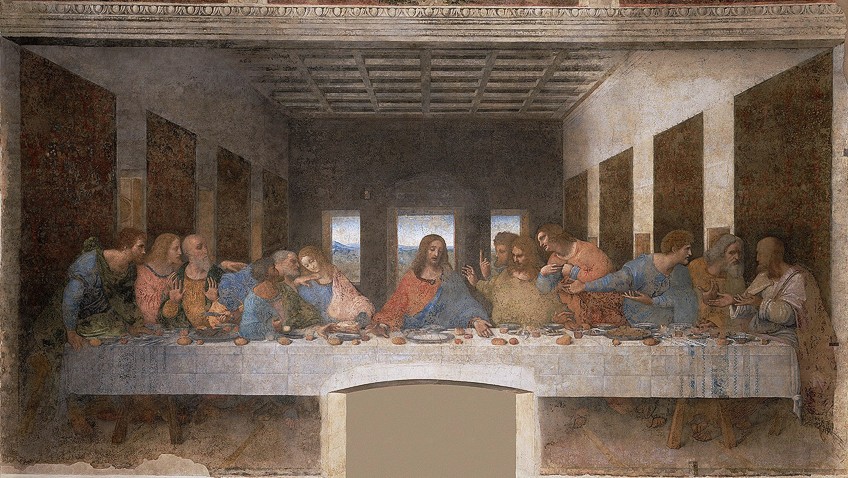
However, due to Da Vinci’s record of leaving paintings unfinished and completing works within large periods, The Last Supper was painted using materials that would cater to this inconsistent approach. Over time, the painting deteriorated and very little remains of the painting’s original splendor. The last attempt at restoring The Last Supper was executed in 1999. Where is The Last Supper painting now?
It is currently housed in the monastery dining room at the convent of Santa Maria delle Grazie in Milan, Italy.
The Last Supper: Analysis of Subject Matter
Portrayed in The Last Supper painting is an important scene familiar to any follower of Christianity. The scene that Da Vinci created in the painting expresses the moment when Christ announced that one of his apostles was about to betray him.
The painting captures the facial expressions of the 12 apostles of Jesus, who were so startled and unsettled at Jesus’ proclamation that some followers even expressed their anger.
The two most significant events in The Last Supper are documented in the Bible under Matthew chapter 26 where Jesus speaks directly to his apostles on the evening before his arrest. He states, “one of you will betray me”. Philip, one of the apostles replies in the wake of the astounding news and asks Jesus, “Lord, is it I?”. Jesus proceeded to confirm his statement by replying “he that dippeth his hand with me in the dish, the same shall betray me”.
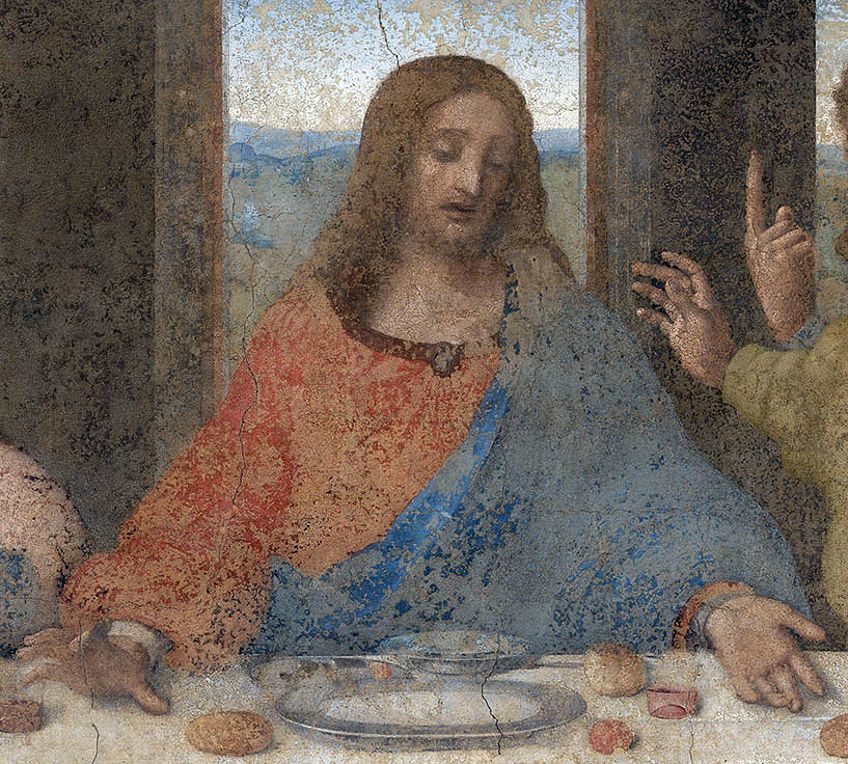
This announcement along with the proclamation of the Eucharist involving Jesus’ blood and body (wine and bread) were the key themes in the painting that make this religious work so important. The apostles were identified as follows, from left to right of the painting:
- The trio of apostles on the far left is Bartholomew, James, and Andrew, who all appear to be taken aback by the announcement.
- Next are Judas, Peter & John, all of whom display varied expressions; Judas appears to be the only apostle whose head is positioned the lowest and has his elbow leaning against the table. Judas, who received payment for betraying Jesus, is seen in a blue and green garment holding a small bag. This is speculated to signify his position as the treasurer and potentially alludes to the silver he received for his betrayal.
- Peter, who is next to Judas, appears to be angry while clutching onto a knife. This is said to be a preface to his reaction when Jesus was later arrested. Peter rests his hand on John’s shoulder and this is a direct reference to the Gospel of John, where he inquired about who was about to betray Jesus.
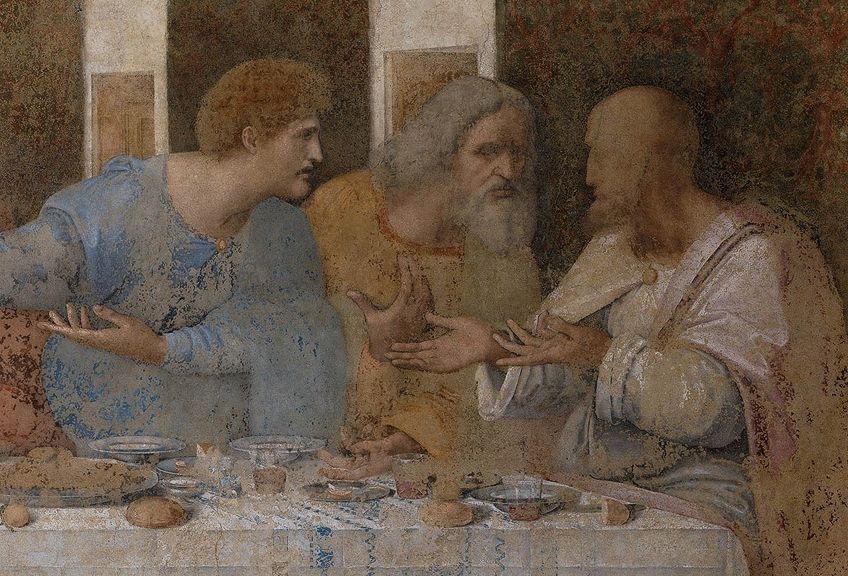
- John, who is the youngest of the 12 disciples of Jesus is seen leaning toward Peter.
- The main character in the painting, Jesus, is seen resting both his hands on the table, showcasing his honesty and openness towards his disciples, despite the news.
- Next to Jesus, are Thomas, James (The Great), and Philip; Thomas appears visibly shaken due to his body language showing his raised index finger. This is said to be a forecast of Jesus’ resurrection. James appears shocked as his arms take to the air and Philip faces Jesus, seeking further explanation from him.
- The last group of apostles to the right of the painting include Matthew, Jude, and Simon. Matthew and Jude appear to turn directly to Simon, who they probably assumed would have the answers to their immediate questions.
Da Vinci depicted Jesus without the traditional halo, which was generally found in most religious paintings. A few academics suggested that the light that shines from behind Jesus suggests an “implied halo”, given the presence of the son of God on its own was enough.
The perspective of the drawing also adds an element of depth to the scene and perhaps also influences the “implied importance” of Jesus and fuels the illusion of an atmospheric halo.
On the other hand, a few scholars have also argued that the lack of a halo on Jesus was intentional and meant to draw attention to Jesus as a human and not just a heavenly figure. This may have been a clever move on Da Vinci’s part since Jesus was to experience much persecution and eventually, death. Jesus’ hands not only lie on the table but they also gesture towards the Holy Communion rite involving the bread and wine, signifying Jesus’ body and blood. Jesus’ facial expression seems to be composed, as though he is at peace with his newfound enlightenment.
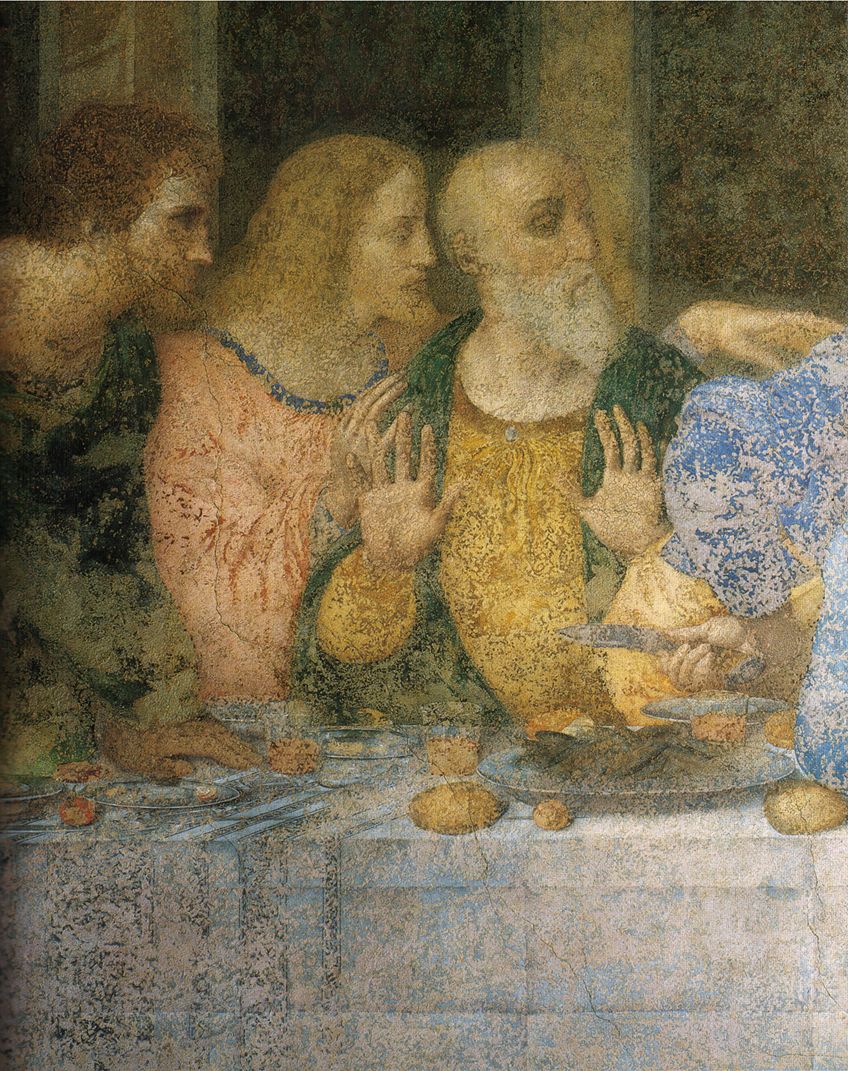
His eyes and head are lowered and stand out from the varied expressions and reactions of the apostles. Other foreboding imagery seen in the painting includes the knife that Peter is holding, which is believed to reference the knife used to cut off the ear of one of the soldiers who tried to arrest Jesus. Thomas’ finger pointing upwards is a reference to another scene in religious art when Thomas touched Christ’s wounds while Jesus was on the crucifix.
Judas, who appears slightly disturbed by the reaction of his fellow apostles, holds onto a purse, which is believed to reference the reward he was paid for pointing out Jesus.
The Last Supper Original
The Last Supper is said to have two other copies that predate the “original”. The earlier drafts were reportedly created by the artist’s assistants. A total of three reproductions exist; one at the Royal Academy of Arts in London created by Italian painter, Giampietrino, another at the Church of St. Ambrogio in Switzerland by Italian artist, Cesare da Sesto, and lastly an oil painting reproduction at the Leonardo da Vinci Museum in Belgium by Andrea Solario.
The plot gets thicker – it was found that Leonardo da Vinci did create a second copy of The Last Supper.
Overheard at a party, Jean-Pierre Isbouts and Christopher Heath Brown, who were working on a book about the great artist, encountered a person who claimed the existence of another version of The Last Supper executed on canvas and which dated after the creation of the original mural.
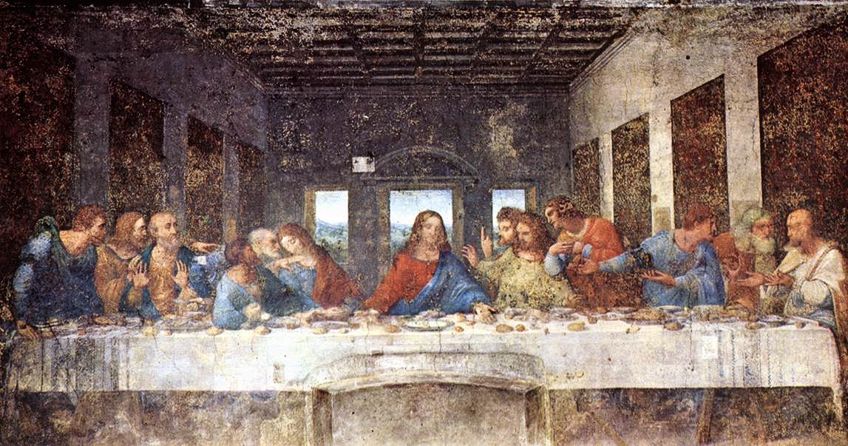
The two authors proceeded to make a documentary, The Search for The Last Supper, where the two discovered that the painting was a match to that of the mural and it even filled in missing portions of the original. The mural at the monastery was admired by many, including King Louis XII of France who visited the monastery and wished to take back the painting to France.
When King Louis XII discovered that the painting, which he heard so much about, was on a wall, he was eager to have a copy made.
Regardless of his seemingly dead-end pursuit, the King stated in a letter in 1507 that “we have a need for Leonardo da Vinci” since France was lacking in the art department. It is upon this evidence that the second original of The Last Supper by Da Vinci is said to have been created by the artist and his studio. The inventory records from the governor of Milan’s estate of 1540 also include mention of a Last Supper painted on canvas that was brought by the King from Milan.
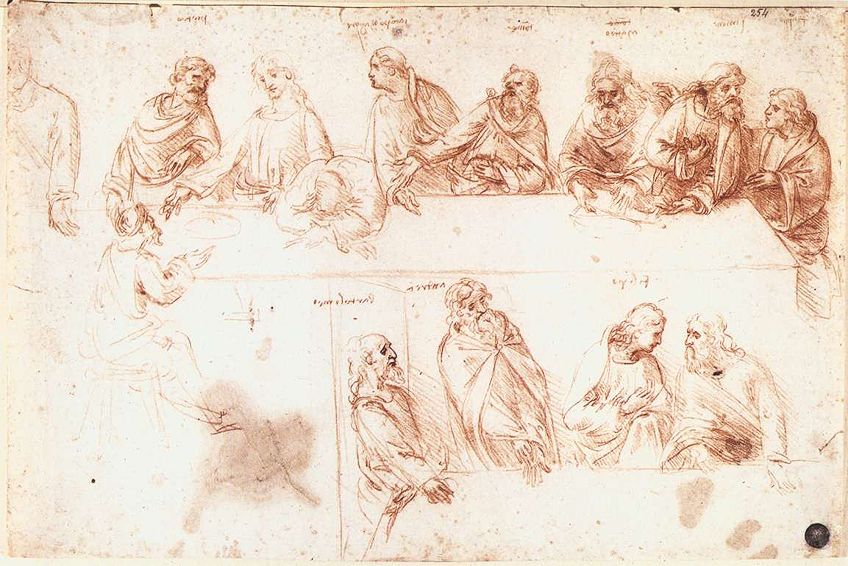
Both Isbouts and Brown believed that it was Andrea Solario, one of Da Vinci’s assistants, who oversaw the project and also worked at the governor of Milan’s estate, the Gallion, since 1507, which was the same time that the painting arrived at the estate.
Another of Da Vinci’s assistants, Giampietrino, produced a copy of The Last Supper not long after the completion of the main mural.
In comparison to Da Vinci’s original painting executed in tempera and oil on the walls of the monastery, Giampietrino’s copy was executed in oil, which allowed for its longevity and is now available on Google Arts and Culture for your enjoyment.
Perspective and Composition of The Last Supper by Da Vinci
The Last Supper is a classic example of linear perspective in painting since Da Vinci sets out the single vanishing point directly behind Jesus’ right temple. This is direct guidance for the viewer towards the center of the painting or the sensus communis of Jesus’ brain.
This is the point from which Da Vinci could radially map out the layout of the floor lines, the table ends, and the six columns.
From either end of the horizon (left or right), Da Vinci could have drawn diagonal lines ending up at the corners of each column to situate points for the 12 coffer rows. The painting is predominantly horizontal and as a great master of symmetry, Da Vinci excelled in execution. The large dining table was placed in the foreground with the disciples and Jesus behind it. Symmetry is also found in the groupings of figures on either side of Jesus, six figures on the left and six figures on the right.

Da Vinci produced various studies for each apostle and this is an indication of the amount of thought and detail put into the composition. Out of the many studies created to plan The Last Supper, only two remain. In one of the haphazard studies for The Last Supper, dated1495 to 1497, Da Vinci could not fit all the figures at the table and instead drew four figures on the floor.
In Study for The Last Supper (c. 1495 – 1497), Da Vinci depicts Judas as isolated from the group – a depiction that was common in earlier renditions of the scene.
The dramatic nature of the scene is accentuated by the facial expressions of the apostles as well as the intricately embroidered tablecloth with many small still lifes. This adds to the genius of Da Vinci and his attention to the scene, thus amplifying its importance. The positioning of the wine glasses, small loaves, and pewter dishes are balanced and laid out in such a manner that not many artists were able to achieve at the time.
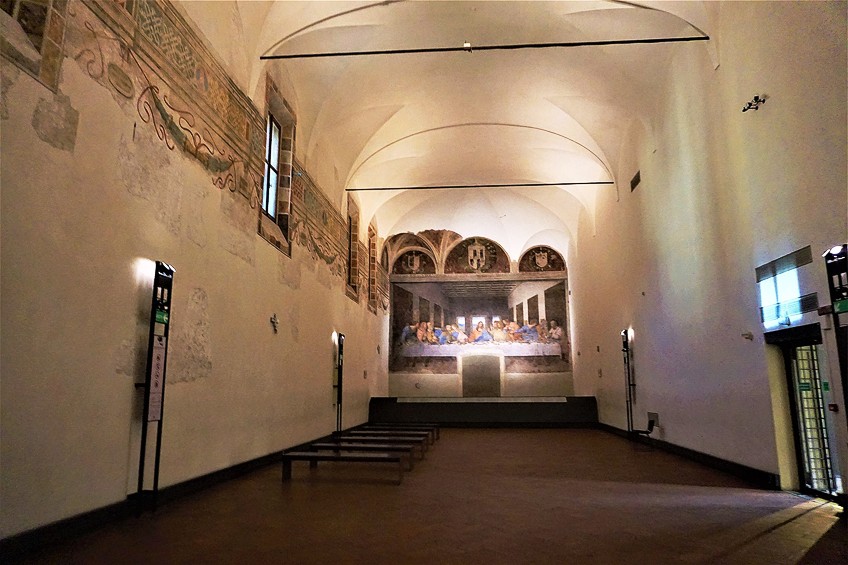
It is all fair and well to review the composition of The Last Supper post-production and in the planning stages but to assess the complexity of the scene is another story. Da Vinci took on the challenging task of attempting to fit 13 men into a painting while demonstrating the topic of discussion around Jesus’ last supper, the holy communion, and showing the traitor, Judas, in isolation.
Da Vinci skillfully achieved this in his master composition, singling Judas out by a simple gesture in his body language (his elbow on the table).
It is said that Da Vinci took 15 years to wrap his mind around his ideas for painting The Last Supper and an indication of his thoughts on the subject can be seen in a sketch for Adoration of the Magi where he illustrates a group of servants engaged in a passionate discussion with another figure resembling Christ nearby. Da Vinci also embedded a lot of emotion into the display of the figures. He states in his Treatise that “the painter has two objectives; man, and the intention of his soul.” The first would be easy and the latter is difficult simply because “he has to represent it by the movements of the limbs”.
For Da Vinci, it was in the motion and the gesture of the figures that emotion was found. The faces that Da Vinci used in The Last Supper (excluding Jesus) were reportedly of people the artist sought out in Milan. For Christ, Da Vinci did consider two options for reference; Count Giovanni who belonged to the house of the Cardinal of Mortaro and for Jesus’ hand, Alessandro Carissimo of Parma. Christ’s face was left as an imagined rendition of a “universally appealing” figure.
Jesus’ posture with his hands spread out in an open manner was said to represent his “submission to the Divine”, such that without the betrayal and crucifixion, man’s salvation would not have occurred.
Luca Pacioli, a mathematician, and friend to Da Vinci stated, upon witnessing the painting come to life, that Jesus’ gesture was “a symbol of man’s burning desire for salvation”. Da Vinci also did a lot of in-depth research into the depiction of Judas. Da Vinci went out of his way to study the criminals of Milan to get an idea of how to paint Judas and was even accused of being lazy by the prior of the monastery. Da Vinci claimed that he experienced trouble finding an appropriate face and wittingly suggested using the prior’s face if he could not find one.
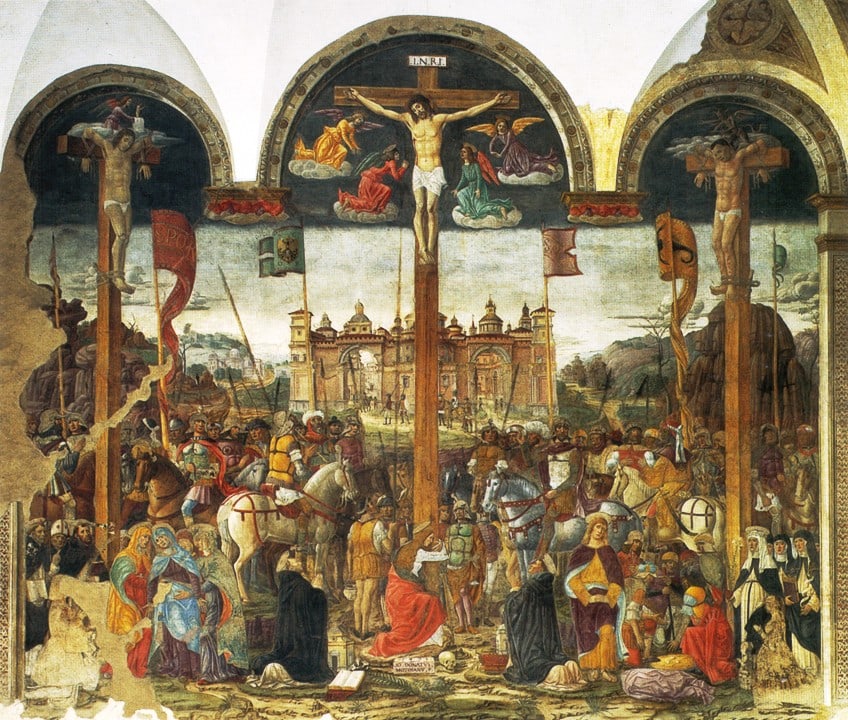
In the final moment of painting Judas, Da Vinci sat Judas alongside the other disciples but isolated him in a “psychological aloneness”, which can be viewed as far more effective than a physical separation. Judas is seen leaning away from Jesus as he bears the guilt with his darkened solitude. An Italian writer who attended priory school also testified that when Da Vinci was at work, he would arrive at dawn and work “’til the shades of evening compelled him to cease, never thinking of food at all, so absorbed was he in his work.”
Da Vinci was indeed very driven to complete the painting and succeeded within three years. The location of the painting was also important in its interpretation.
The painting was situated in the monastery’s dining hall, which at the opposite end of the hall was the prior’s table on a raised dais. Between the painting and the prior’s table were the monk’s tables. Da Vinci depicted similar cutlery and an almost identical tablecloth for the table in The Last Supper as that of the monk’s tables. According to Da Vinci, it was Christ who presided as the “spiritual prior” who “would eat the food of mortal men”. The placement of this painting was considered just as much as the composition and proves that Da Vinci, although slow to finish an artwork, was still a genius.
Points of Interest in The Last Supper
The Last Supper by Da Vinci took the world by storm. Many artists and art lovers look at the painting as the perfect display of the biblical scene. Art historians debated that Da Vinci did not include a halo for the reason that he did not believe in God and perhaps chose to illustrate nature – something he was passionate about. Although Da Vinci employed such passion in the making of the painting, his technique did not fare well on the walls of the monastery.
After only a few years, his painting started to flake away because his tempera method on the plastered wall of the monastery was weak and considered more of an experiment than any real thought for execution.
Gabriele D’Annunzio, an Italian poet, wrote in his Ode on the Death of a Masterpiece in 1901 regarding the countless retouching projects of The Last Supper. He wrote, “O Poets, it is no longer.” Not long after, an attempt at restoration was made and lasted over 30 years to repair the “skin” of the painting.
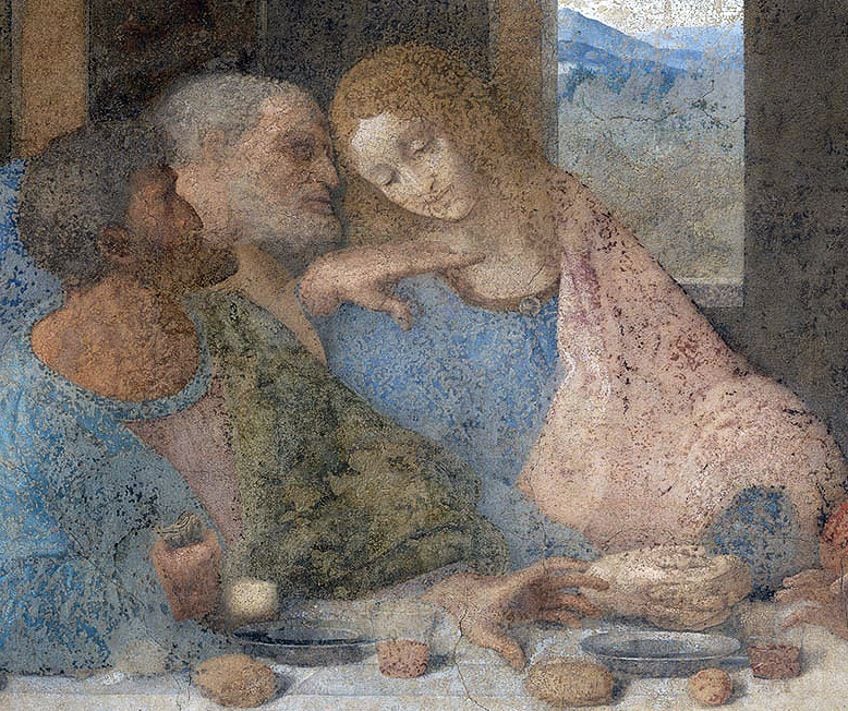
A heating system was installed but midway through, the project director was sent to exile. The work we have available today is also not entirely credited to Da Vinci. Although he may have set the framework and subject matter, much of the painting can be owed to the restoration expert, Panin Brambilla Barcilon, who alongside his team, utilized microscopic photographs, infrared reflectoscopy, core samples, and sonar to remove the later additions of paint and restore the painting from its original.
Subject to further damage, the artwork once contained the feet of Jesus under the table, however, around 1652, a new door was cut into the already dilapidated painting, which destroyed a portion of the painting.
During the final stages of the 18th century, the painting faced even more destruction through bombings executed by Napoleon’s soldiers. The Nazis also had their turn in World War II, bombing the surrounding walls of the monastery to smithereens. The artwork can therefore be said to be a painting that has not survived, but rather one that has been kept alive.
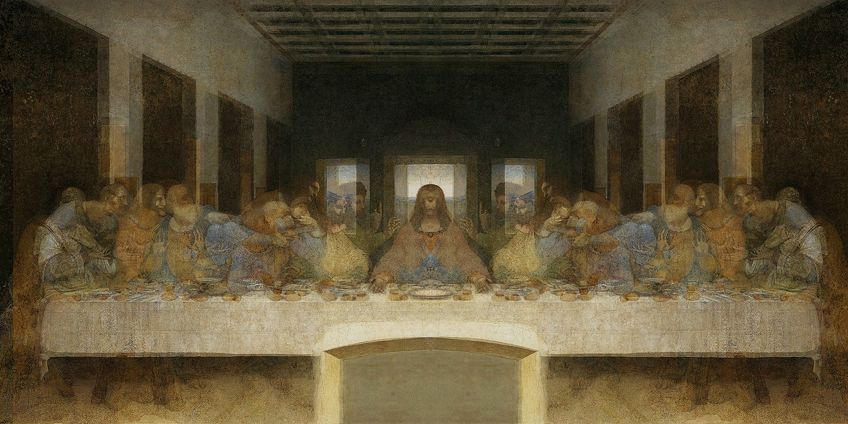
Certain elements in The Last Supper may also carry additional meaning. A lot of speculation has circulated around the salt on the table and Da Vinci’s choice of food. The spilled salt that is situated next to Judas’ elbow is said to be a symbol of bad luck or perhaps a reference to Jesus, being the salt of the earth.
The dispute over what type of fish is on the table is also interesting as some speculate that it could be an eel or a herring. The Italian word for eel is arringa, which means to “indoctrinate”.
According to Northern Italian linguistics, part of the word renga denotes an individual who denies religion – fitting for the artist Da Vinci. This could also be a foreshadow of Christ’s prediction that his apostle, Peter, would deny ever knowing him. After the ramifications of the painting’s condition in World War II, the painting was coated with a layer of shellac to reduce the moisture issues since the church was also prone to floods. It was in 1977 that the government of Italy partnered with private bodies on a large restoration project that involved the uncovering of the original artwork.
The project, led by Barcilon, took more than 20 years to finish as the team scraped away at the surface with great attention to detail. The painting was completely “restored” around 1999 and received a new climate-controlled home. As you might imagine, the painting’s long-awaited restoration and the big reveal were also subject to criticism. Many believed that the restoration efforts diminished the original artistic value of Da Vinci and hence, The Last Supper by Da Vinci is no longer a true Da Vinci painting but an effort of restoration.
Approximately 42.5% of the painting remained intact as Da Vinci’s original work, while 17.5% was completely lost and the other 40% was the work of restoration.
Further Speculations About The Last Supper
You may have also encountered mention of Da Vinci’s The Last Supper in Dan Brown’s fiction-based novel, The Da Vinci Code. The book suggests that John, swaying next to Jesus was depicted as feminine and was most likely to represent Mary Magdalene. This, of course, was not true in reality but some side with Brown’s version due to the traditional notion of “feminine” traits.
Out of the four gospels, there was also no mention of Mary at the last supper and her role in the Bible was that of a supporting character. What do you think?
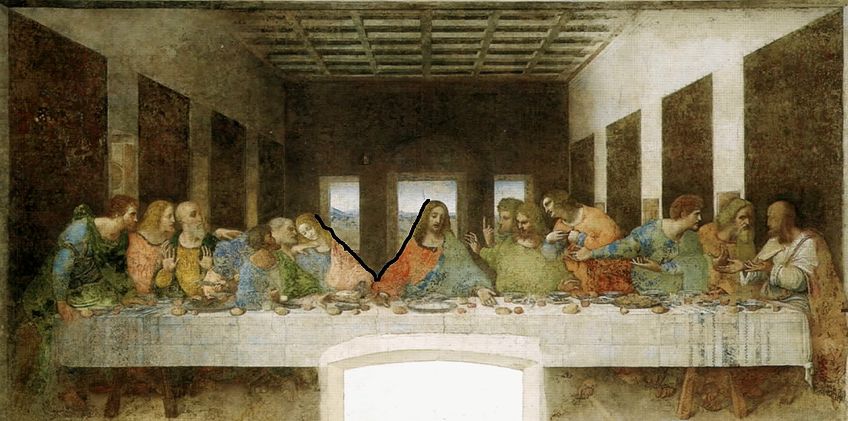
Leonardo da Vinci was also famous for incorporating the golden ratio into many of his drawings, providing a mathematical foundation for many of his works, including The Last Supper. The painting draws many references to the number three, which is said to be symbolic of the Holy Trinity. There are also three windows in between Jesus’ outstretched hands, as well as the vanishing point behind him to create a triangle.
Was this simply the application of mathematics, linear perspective, and clever composition for the aim of perfection, or was this symbolic of more?
Where Is The Last Supper Painting Now?
The Last Supper painting remains in its original location on the walls of the Dominican convent at Santa Maria delle Grazie. The painting is also now protected from deterioration, following its many encounters with destruction.
The visitor entry capacity is now restricted to a maximum of 25 individuals per 15 minutes.
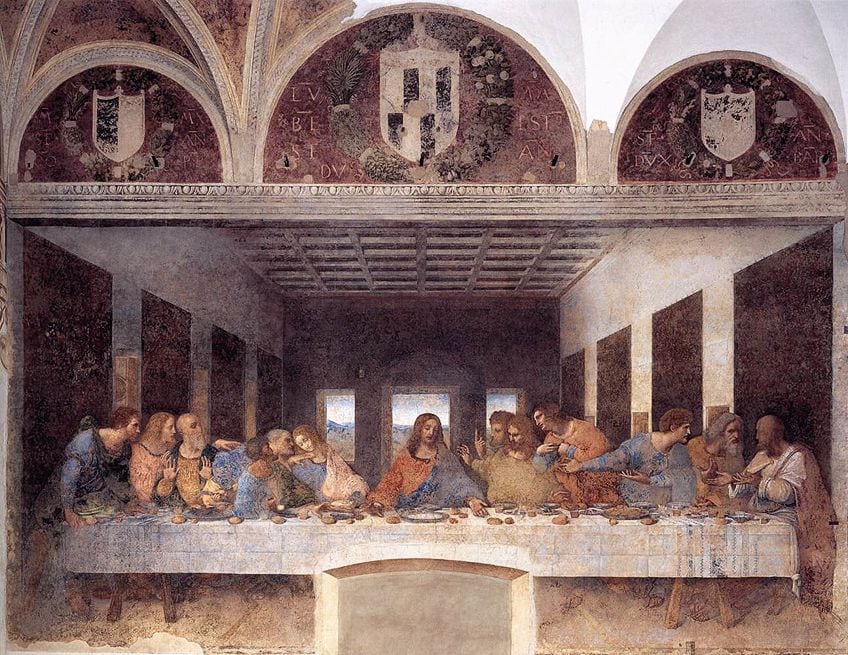
The Last Supper by Da Vinci is regarded as one of the most famous paintings in the world and surely from this article, you can see why. Jam-packed with symbolism, religious significance, and a history defined by survival and restoration, this painting is sure to engrain itself in your memory as a masterpiece with determination.
Frequently Asked Questions
Who Painted The Last Supper?
The Last Supper (c. 1495 – 1498) was painted by Leonardo da Vinci, an Italian polymath.
Where Is The Last Supper Painting Located?
The Last Supper (c. 1495 – 1498) painting is located in the dining hall of the monastery, Santa Maria delle Grazie, in Milan, Italy.
Who Are the 12 Apostles in The Last Supper?
The twelve apostles seated in The Last Supper (c. 1495 – 1498) from left to right are: Bartholomew, James, Andrew, Judas, Peter, John, Thomas, James (The Great), and Philip. Jesus is seated in the middle.
Why Is The Last Supper by Da Vinci Significant?
The Last Supper (c. 1495 – 1498) by Da Vinci is significant because it not only represents one of the most important biblical scenes of Jesus’ last supper before his arrest and crucifixion, but it is also a technical masterpiece and display of linear perspective by one of Italy’s greatest artists. The scene is also embedded with symbolism about the Holy Communion rite and the betrayal of Jesus Christ by Judas.
How Many Copies Are There of The Last Supper?
There are three copies in total of The Last Supper (c. 1495 – 1498); one created by Giampietrino in London’s Royal Academy of Arts, another by Cesare da Sesto in the Church of St. Ambrogio in Switzerland, and another by one of Da Vinci’s assistants, Andrea Solario, at the Leonardo da Vinci Museum in Belgium. The Last Supper original was produced by Leonardo Da Vinci.
Who Is the Woman in The Last Supper?
The woman in The Last Supper (c. 1495 – 1498) is not a woman, rather it is the apostle John who is often speculated to be Mary Magdalene. The figure also wears a pendant and hence is easily confused for a woman.
Jordan Anthony is a Cape Town-based film photographer, curator, and arts writer. She holds a Bachelor of Art in Fine Arts from the University of the Witwatersrand, Johannesburg, where she explored themes like healing, identity, dreams, and intuitive creation in her Contemporary art practice. Jordan has collaborated with various local art institutions, including the KZNSA Gallery in Durban, the Turbine Art Fair, and the Wits Art Museum. Her photography focuses on abstract color manipulations, portraiture, candid shots, and urban landscapes. She’s intrigued by philosophy, memory, and esotericism, drawing inspiration from Surrealism, Fluxus, and ancient civilizations, as well as childhood influences and found objects. Jordan is working for artfilemagazine since 2022 and writes blog posts about art history and photography.
Learn more about Jordan Anthony and about us.
Cite this Article
Jordan, Anthony, ““The Last Supper” by Da Vinci – “The Last Supper” Painting Study.” artfilemagazine – Your Online Art Source. August 18, 2022. URL: https://artfilemagazine.com/the-last-supper-by-da-vinci/
Anthony, J. (2022, 18 August). “The Last Supper” by Da Vinci – “The Last Supper” Painting Study. artfilemagazine – Your Online Art Source. https://artfilemagazine.com/the-last-supper-by-da-vinci/
Anthony, Jordan. ““The Last Supper” by Da Vinci – “The Last Supper” Painting Study.” artfilemagazine – Your Online Art Source, August 18, 2022. https://artfilemagazine.com/the-last-supper-by-da-vinci/.


